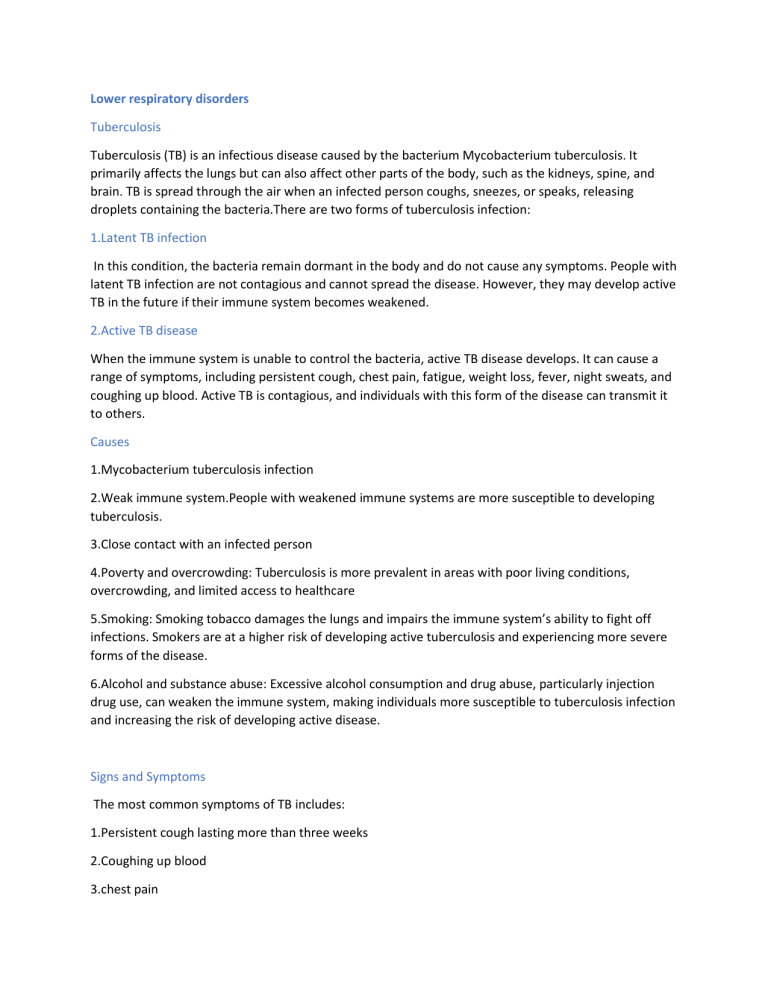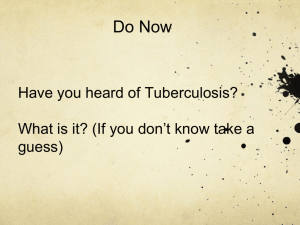
Lower respiratory disorders Tuberculosis Tuberculosis (TB) is an infectious disease caused by the bacterium Mycobacterium tuberculosis. It primarily affects the lungs but can also affect other parts of the body, such as the kidneys, spine, and brain. TB is spread through the air when an infected person coughs, sneezes, or speaks, releasing droplets containing the bacteria.There are two forms of tuberculosis infection: 1.Latent TB infection In this condition, the bacteria remain dormant in the body and do not cause any symptoms. People with latent TB infection are not contagious and cannot spread the disease. However, they may develop active TB in the future if their immune system becomes weakened. 2.Active TB disease When the immune system is unable to control the bacteria, active TB disease develops. It can cause a range of symptoms, including persistent cough, chest pain, fatigue, weight loss, fever, night sweats, and coughing up blood. Active TB is contagious, and individuals with this form of the disease can transmit it to others. Causes 1.Mycobacterium tuberculosis infection 2.Weak immune system.People with weakened immune systems are more susceptible to developing tuberculosis. 3.Close contact with an infected person 4.Poverty and overcrowding: Tuberculosis is more prevalent in areas with poor living conditions, overcrowding, and limited access to healthcare 5.Smoking: Smoking tobacco damages the lungs and impairs the immune system’s ability to fight off infections. Smokers are at a higher risk of developing active tuberculosis and experiencing more severe forms of the disease. 6.Alcohol and substance abuse: Excessive alcohol consumption and drug abuse, particularly injection drug use, can weaken the immune system, making individuals more susceptible to tuberculosis infection and increasing the risk of developing active disease. Signs and Symptoms The most common symptoms of TB includes: 1.Persistent cough lasting more than three weeks 2.Coughing up blood 3.chest pain 4 Weakness or fatigue 5.Weight loss 6 Loss of appetite 7.Fever 8.Night sweats. However, the symptoms can vary depending on the part of the body affected Management of tuberculosis The management of tuberculosis (TB) involves several key components, including diagnosis, treatment, preventions, infection control, and patient support and education . Here is an overview of the management strategies for tuberculosis: Diagnosis TB is diagnosed through various tests, including : 1 .tuberculin skin test (also known as the Mantoux test) 2.blood test 3. chest X-ray 4.culture If these tests suggest TB, further tests like sputum culture, nucleic acid amplification tests (NAATs), or a biopsy may be done to confirm the diagnosis. Treatment TB is treatable with a combination of antibiotics. The standard treatment involves a six-month course of several drugs, such as isoniazid, rifampin, pyrazinamide, and ethambutol. It’s important to complete the full course of treatment to ensure the bacteria are completely eradicated and to prevent the development of drug-resistant strains. Drug-resistant TB :Some strains of TB have developed resistance to the antibiotics commonly used to treat the infection. Multidrug-resistant TB (MDR-TB) is resistant to at least two of the most effective drugs, isoniazid and rifampin. Extensively drug-resistant TB (XDR-TB) is even more resistant and poses greater challenges for treatment. Prevention To prevent the spread of TB, it is important to maintain good respiratory hygiene, such as: 1. covering the mouth and nose when coughing or sneezing 2. ventilating rooms. In addition, the Bacillus Calmette-Guérin (BCG) vaccine is available in some countries and can provide partial protection against severe forms of TB, particularly in children. Infection control: TB is an airborne disease, so infection control measures are crucial to prevent transmission. o o Strategies include proper ventilation, use of respiratory protection (masks), isolation of infectious individuals, and maintaining cough etiquette. Screening and treatment of close contacts to identify and treat latent TB infection are also important for preventing new cases. Patient support ,follow-up and education o o o Patients with TB require support and education throughout the treatment process. Adherence to the treatment regimen is critical, and healthcare providers should closely monitor patients to ensure they complete the full course of medication. Regular follow-up visits, monitoring for drug side effects, and addressing any concerns or questions the patient may have are important aspects of patient support. Collaboration and coordination o o Managing TB requires a multidisciplinary approach involving healthcare providers, laboratories, public health departments, and other relevant stakeholders. Collaboration and coordination among these entities are essential for effective case management, contact tracing, and surveillance. Conclusions It's Important to note that specific guidelines and protocols may vary depending on the country or region, as well as the prevalence of drug-resistant strains of TB. Therefore, it is recommended to refer to the guidelines provided by the World Health Organization (WHO) or local health authorities for the most up-to-date and region-specific information on TB management. It’s worth noting that medical information is subject to change and it’s always best to consult a healthcare professional or refer to reputable sources for the most up-to-date information on tuberculosis.



